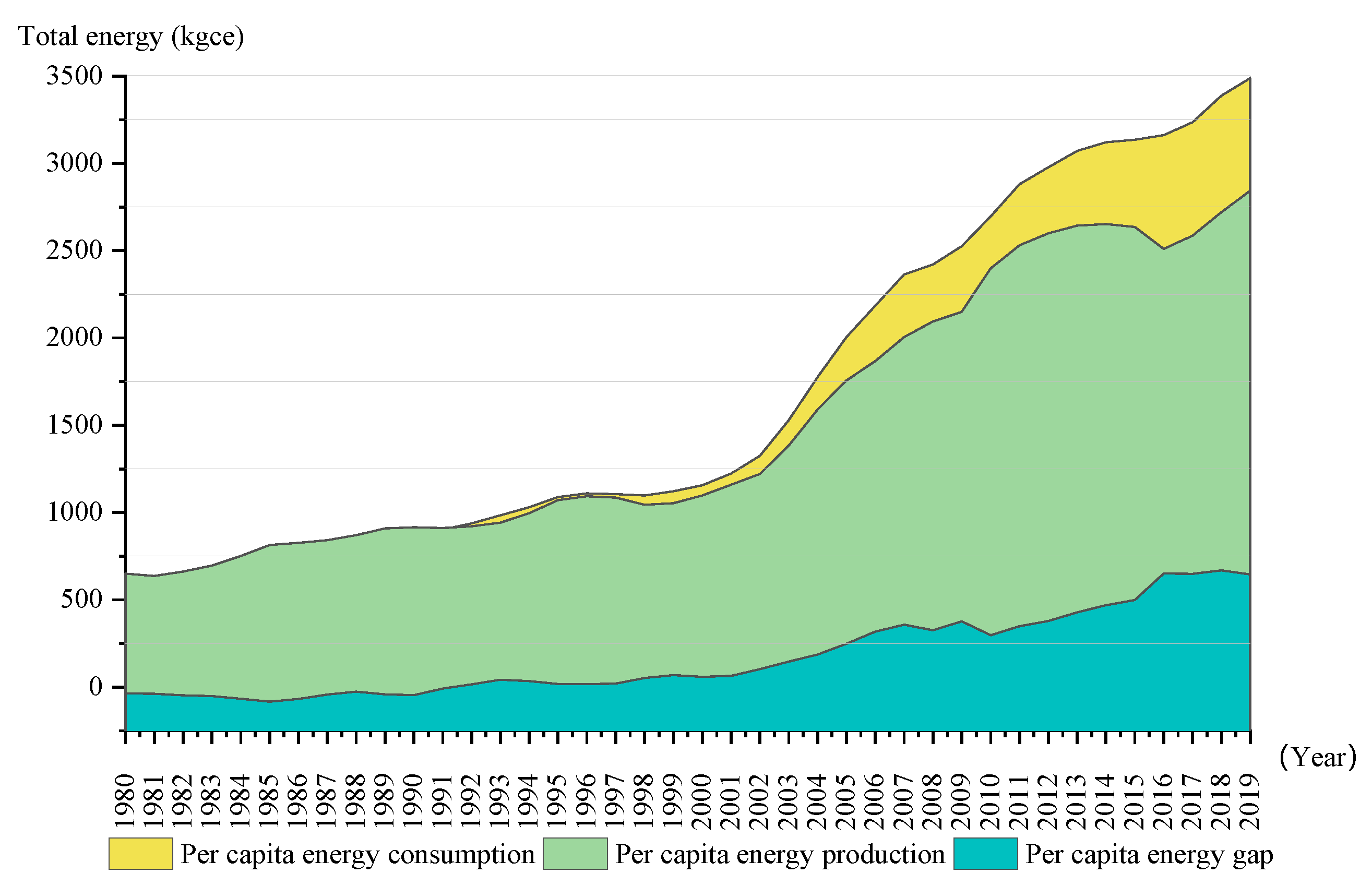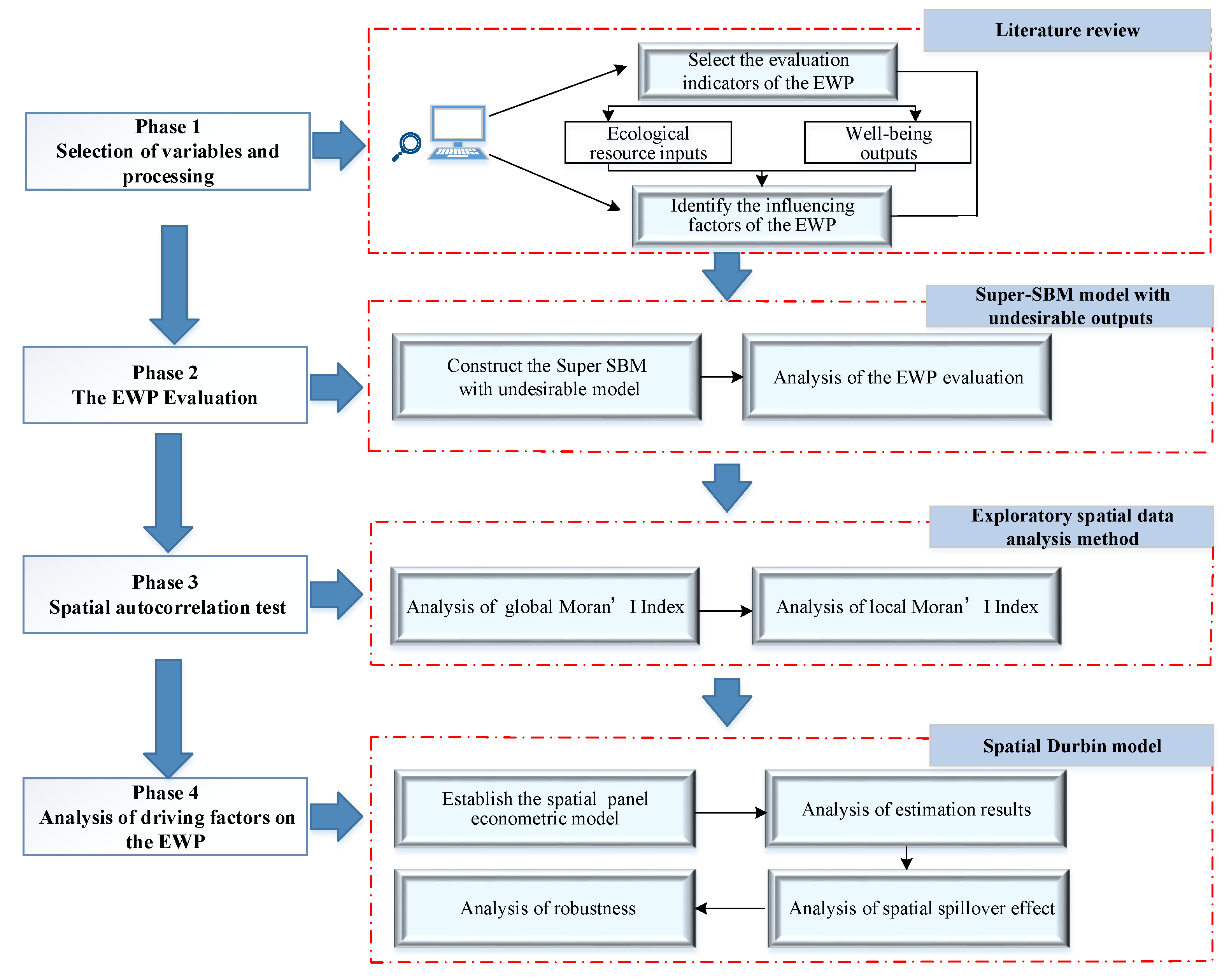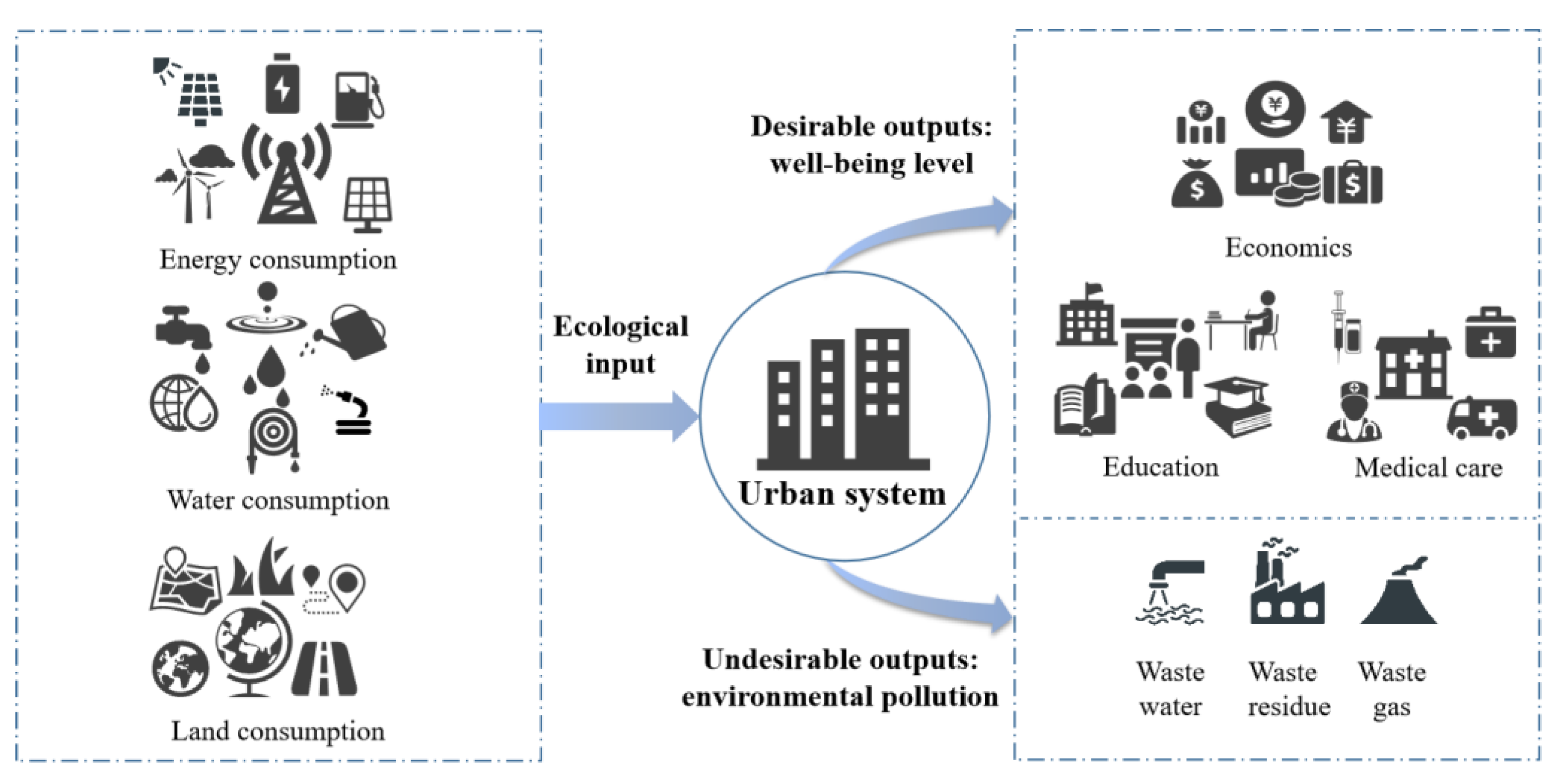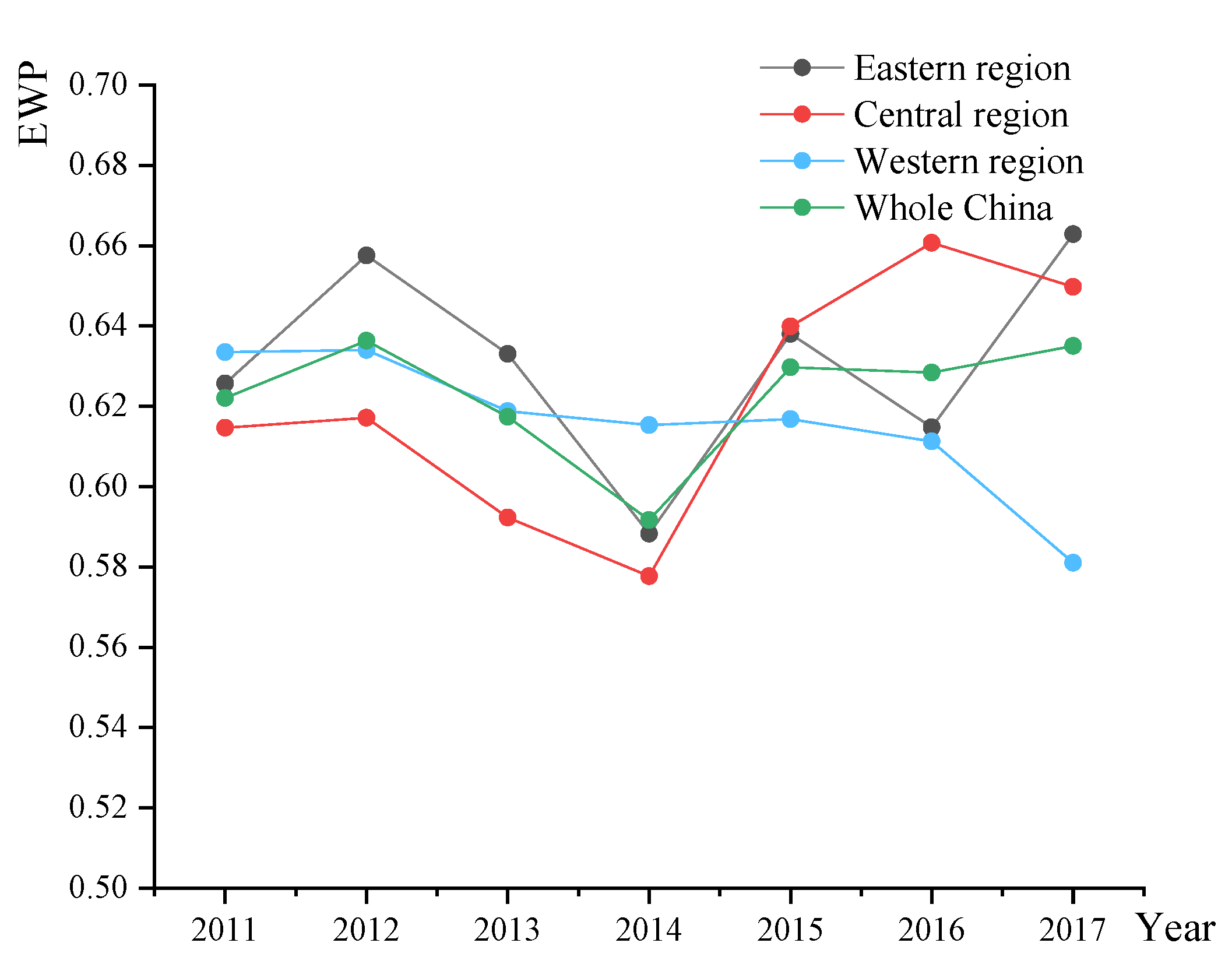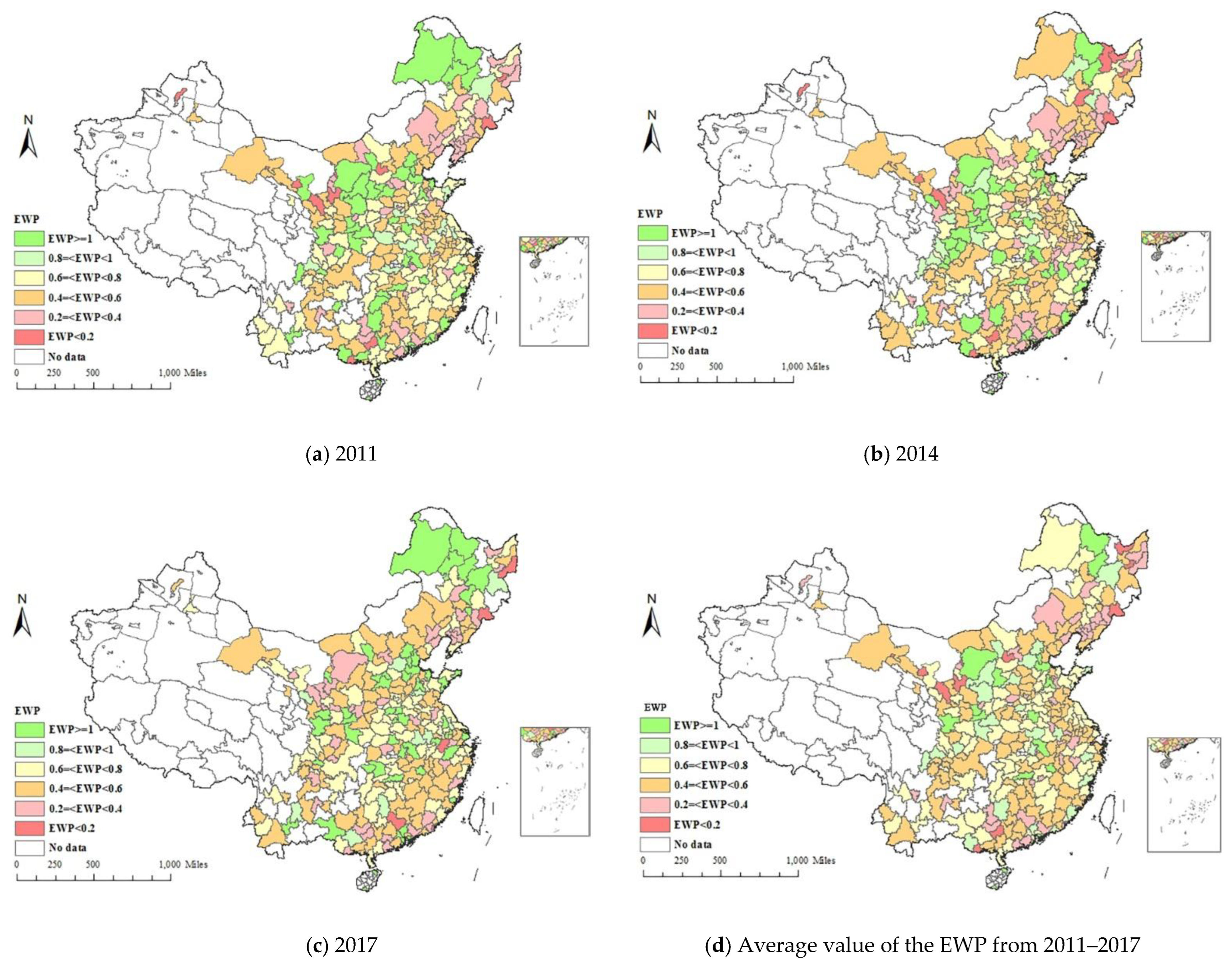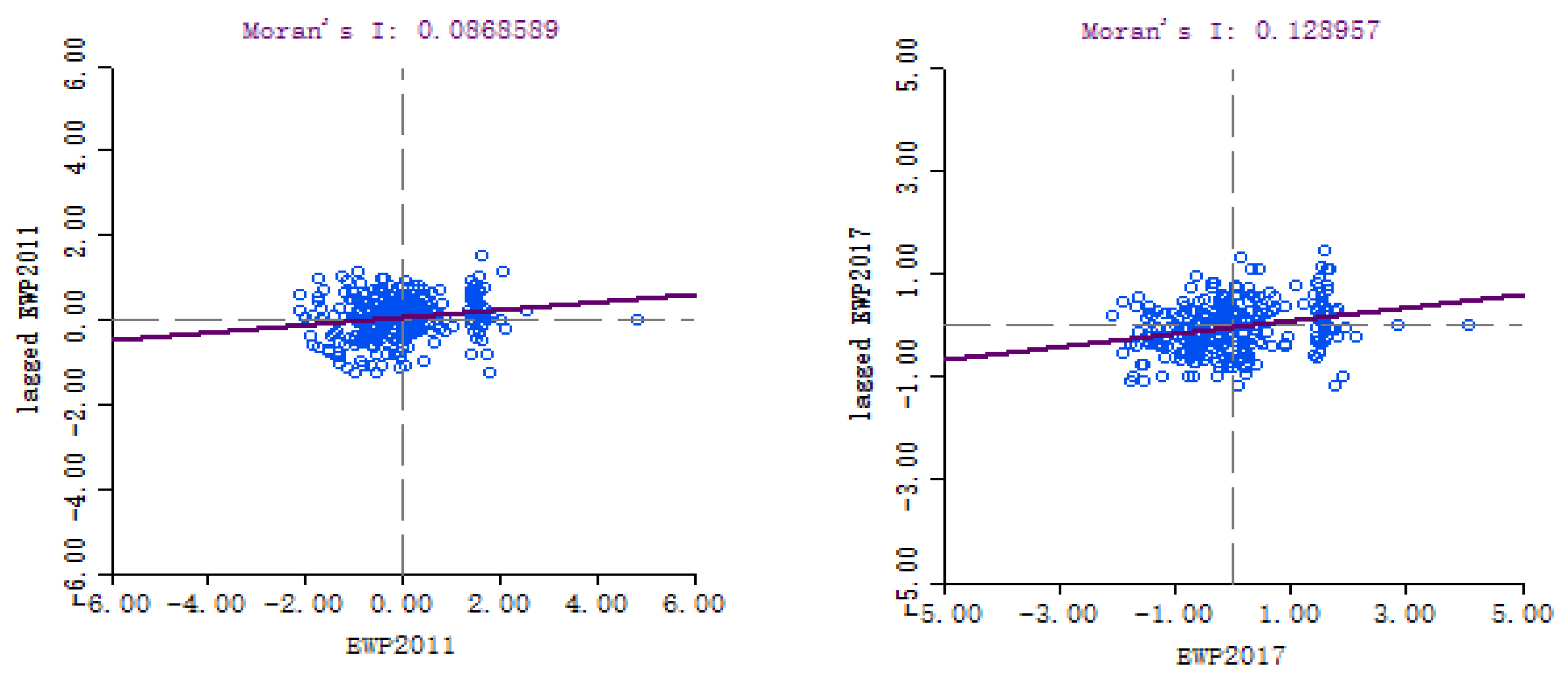1. Introduction
The rapid urbanization development in China has made significant progress, but it has also faced many challenges. Environmental deterioration, a lack of resources, a shortage of resources and other ecological problems have seriously damaged the ecosystem, which has hindered the promotion of people’s well-being and the ecological civilization. The proportion of population who are urban residents will raise to 68% in 2050 [
1]. With the rapid increase of global population, the problem of resource consumption has become increasingly serious [
2]. As shown in
Figure 1, the total energy consumption per capita in China was 3488 kgce in 2019, nearly 5.68 times those of the total consumption in 1980 [
3]. Meanwhile, the problems of “urban diseases” appear, for example, as a result of insufficient water supply, urban traffic congestion, low land use efficiency, insufficient public infrastructure construction and so on, which bring severe challenges to urban development. Climate change, ecological environmental damage and other issues are intertwined, affecting people’s health, economic and other well-being levels in different ways [
4,
5].
China has actively been promoting a new type of urbanization for solving serious ecological environment problems and improve people’s well-being in recent years. China’s urban construction has changed from extensive development to a new type of urbanization. The 14th Five-Year Plan (2021–2025) clearly proposed the goal of achieving new progress in the building of a Beautiful China and a new level of people’s livelihood. The economic system is subordinate to the ecological system, rather than an independent and unrestricted system [
6]. Ecological well-being is the expansion of the connotation of social well-being, which has raised sustainable development and quality of life to a more important position [
7]. Ecological well-being performance (EWP) refers to the efficiency of transforming natural consumption into human well-being [
8]. Therefore, it is an inevitable tendency for promoting the EWP and high-quality development under the constraints of ecological resources.
The research on the EWP is developing in the continuous global search for a healthy and benign economic development model, and has highly concerned scholars in recent years [
9]. Some of the existing literature has carried out comprehensive analysis of the EWP evaluation, space distribution of the EWP and its driving factors. The evaluation methods of the EWP mainly include two types [
10]. First is the single-factor evaluation method, and the proportion of well-being level to natural consumption is used to estimate the EWP [
11]. Well-being level is usually measured by the Human Development Index (HDI) or average life expectancy, and ecological consumption is usually measured by ecological footprint (EF) [
12]. For example, Daly initially used the ratio of natural consumption (service) to well-being level (ecological resource throughput) for calculating the sustainable development level of a national region [
13,
14]. Abdallah et al. [
15] put forward the Happy Planet Index (HPI), which measured the longevity and happiness of life. The other is comprehensive evaluation method, such as Data Envelopment Analysis (DEA) and Stochastic Frontier Analysis (SFA) [
16]. For example, Hu et al. used the network DEA model to estimate the EWP, and analyzed the evolution and impact of the urban EWP in the Yangtze River Delta [
17]. Xiao et al. adopted the improved SFA model to estimate the EWP of 79 Chinese cities in the Yellow River Basin [
18]. Bianchi et al. used the DEA model to assess the comparable development of eco-efficiency and the geographical heterogeneity in the European region between 2006 and 2014 [
19]. Moutinho et al. used a two-stage DEA method to measure the eco-efficiency scores of European Union countries from 2008 to 2018 [
20].
There are great differences in economic development, resource endowments and energy consumption in different Chinese regions, and different regions have spatial differences in terms of the EWP. For example, Wang et al. explored the spatial and temporal differentiation characteristics of the EWP of 30 provinces in China [
21]. Li et al. selected the Yellow River Delta as the research area, and adopted the coupling coordination degree model to research spatiotemporal evolution, and used the geographic weighted regression model to analyze the influencing mechanism of the EWP [
22]. Deng et al. used the kernel density estimation method and Markov chain to reveal the spatial disequilibrium and dynamic evolution characteristics of the EWP [
23]. Zheng et al. used the exploratory spatial data analysis (ESDA) method to explore the spatial-temporal distribution pattern of the EWP in China [
24]. Kounetas et al. used a nonparametric model to estimate patterns of convergence or divergence of environmental performance in U.S. states from 1990 to 2017 [
25]. It has become an important direction to carry out the spatial and temporal evolution research of the EWP and simulate the change trend of the EWP.
Many studies have been conducted to explore the driving factors of the EWP. The traditional quantitative methods such as Tobit model, Logarithmic Mean Divisia Index (LMDI) method and other econometric model have been extensively employed to explore driving factors of the EWP. For example, Dietz et al. [
26] studied the relationship between human well-being environment intensity and economic growth in 58 countries, and they argued that the result was opposite to Kuznets curve. Jorgenson, et al. [
27] analyzed the dynamic relationship between human well-being energy intensity and economic growth in 12 European countries. Behjat and Tarazkar [
11] employed the autoregressive distributed lag model to reveal influencing factors of the EWP in Iran from 1994 to 2014, finding that the population growth has a negative effect on the EWP. Silva et al. selected Brazil as a case study, and adopted spatial regression models to explore the impacts of the affluence and income inequality on the environmental intensity of well-being [
28]. Ahmed [
29] analyzed the driving factors of natural resources abundance, human capital, and urbanization on the ecological footprint in China. Xiao and Zhang [
30] used Tobit model to explore the influence mechanism of the EWP, and the study showed that green technology innovation efficiency had a positive impact on the EWP.
By summarizing the existing literatures, the research of the EWP evaluation, space distribution and driving factors are in the stable increase period, and there are relatively rich research results and considerable research foundation. However, there are still some deficiencies in relevant literatures. The EWP study mainly focuses on the national and provincial scales, but pays little attention to the urban EWP. The data of these scales have some limitations in reflecting the internal heterogeneity of regional development, so it is essential to carry out the research on urban EWP. Furthermore, the spatial and temporal evolution characteristics of the EWP has not been sufficiently explored, and the spatial effect of driving factors on the EWP needs to be further considered. The traditional econometric analysis usually ignores the existence of spatial correlation and does not consider whether the EWP has the effects of spatial spillovers, affecting the accuracy of analysis results. Consequently, it is necessary to study the spatial and temporal evolution characteristics of the EWP and analyze the spatial effects of driving factors on the EWP.
Therefore, the aims of this study were: (1) to use the Super-SBM model for estimating the EWP of 285 prefecture-level cities in China, and to propose the ESDA method for exploring the spatial and temporal evolution characteristics of the EWP; (2) to adopt spatial econometric model for analyzing driving factors of the EWP; (3) to design strategies for enhancing the EWP with urban characteristics. The major novelty of this study is summed up as follows. (1) Existing literatures usually ignores the spatial effects of the urban EWP. The ESDA method is employed in this study, which can reveal spatial agglomeration characteristics of the EWP. (2) On the basis of considering temporal heterogeneity and spatial heterogeneity, the spatial panel Durbin model is used to test the spatial spillover effect of the EWP, which further enriches the theoretical research in this field. (3) The EWP presents a new study perspective for urban sustainable construction, and the analyzed results and policy implications are conducive to accelerate the implementation of urban management decisions and promote regional sustainable development.
5. Conclusions and Policy Implications
5.1. Conclusions
The spatial and temporal evolution characteristics of 285 Chinese prefecture level cities were analyzed from 2011–2017. The SDM was built to reveal the driving factors of the EWP with the spatial panel data. The main conclusions showed that:
First, from the evaluation of the EWP, the average EWP value of 285 Chinese cities was 0.6229, and the efficiency value was relatively low. The trend of overall EWP has experienced a stage evolution process of “upward → downward → upward”. The cities of average EWP in eastern and central region rated first and second, and cities in western region ranked third according to the EWPs. Due to the coastal geographical advantages and priority support of policies, the levels of economy, education and medical care in the eastern region are evidently superior.
Second, from the spatial autocorrelation analysis, it is reasonable to conclude that Moran’s I index of the EWP during the study period was greater than 0. There was spatial agglomeration of the EWP in 285 Chinese cities, and the spatial effect was significantly positive. The spatial agglomeration types of the EWP were mainly HH type and LL type. The urban EWPs have significant spatial agglomeration and path dependence.
Third, the economic development level and technological progress had significant roles in promoting the EWP. The urbanization level, industrial structure and economic extroversion had negative effects on the EWP. The impacts of urban compactness and urban greening level on the EWP were not significant. The negative spatial spillover effect of urbanization level on the EWP was significant.
Nonetheless this study has some deficiencies, and the topic needs further research. With regard to aspects of the EWP evaluation, there are some limitations in data collection of city scale. When these data can be developed in the future, the evaluation indicators need to be enriched, such as the education development level, medical development level and subjective well-being indicators. The time span of the EWP established in this paper only includes 7 years. If the follow-up research can establish the EWP time series with a time span of 10–20 years, it can further study the spatial and temporal evolution pattern of the EWP scientifically. The driving factors of the EWP only analyze social and economic factors such as economic development level, urbanization level and so on, but not include natural environmental factors such as climate and altitude.
5.2. Policy Implications
First, it is found that there are positive spatial autocorrelation and path dependence of the EWP. The cities in the eastern region have higher economic, educational and medical level, and superior environmental supervision. The EWPs of 285 Chinese prefecture-level cities have obvious spatial correlations. Urban agglomerations in the eastern region should continue to maintain the spatial agglomeration mode of high EWP value, and promote the coupling development of ecology and economy. The regions with low EWP should avoid the diffusion of LL type clusters and improve the ability of independent innovation.
Second, the range of ecological environment and resource-carrying capacity should be promoted. It is therefore recommended that the government solve the problem of agricultural transfer population, improve medical and educational conditions, and enhance the construction of urban infrastructure.
Finally, the technological innovation of ecological environment should be improved. The incentive policies for technological innovation need to be improved, such as tax incentives, innovation subsidies and so on. In addition, the transformation achievements of science and technology in the ecological environment should be strengthened. The scientific and technological support systems for ecological environments need to be built.
